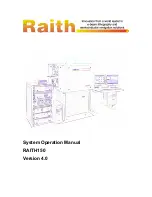
33
●
REPAIRING SCRATCHES
The entry of foreign matter into the hydraulic breaker or the use of degraded or contaminated hydraulic oil
can result in scratches on the inner wall of the cylinder, the external surface of the piston, the external
surface of the valve, or on the inner wall of the cylinder sleeve. These scratches may increase oil leakage,
generate excessive heat, and damage the U-packing. If these scratches are unattended, parts may seize,
causing the breaker to malfunction. In the worst possible case, the breaker may become inoperative. The
valve, valve box and valve box sleeve can also be scratched in the same way. It is, therefore, necessary to
detect scratches early in their development and repair the scratches in an appropriate manner. Delay in
repairing scratches may make repair impossible.
Note:
The criteria for judging scratches and finishes are based on the standard external surface roughness
piece which conforms to JIS B 0659.
I
G
H
F E E D
C B A
Cylinder
(1) Surface roughness of the upper large diameter section (A) of the cylinder: 6.3S
Pay special attention to the area from the end surface to the first groove and repair any scratches in the area
to prevent charged gas from leaking. To remove scratches, use a round or half-round oilstone while
applying cleaning oil. The diameter of the oil stone should be as large as possible. Then finish the surface
with #800 grinding paper to a surface roughness of 6.3S or less.
(2) Surface roughness of the cylinder’s inner surfaces (B and C) other than the above mentioned surface: 12.5S
To repair scratches on the inner diameter surface, use a coarse round oilstone while applying cleaning oil.
To remove burrs inside the seal grooves, use a comb-shaped diamond file. To finish the surface, use a
coarse square oilstone while applying cleaning oil. Then use #800 grinding paper to finally finish the
surface.
● When an electric power supply is available, use a portable electric drill with grinding paper wrapped around the
end of a rod to roughly remove the scratches. Then use flex hone to finish the surface. Quick finishing is
possible with this method.
Piston
(1) Surface roughness of the upper and lower small diameter sections (D and F): 1.6S to 3.2S
To repair scratches, use a coarse square oilstone while applying cleaning oil until the surface roughness is
6.3S or less. Then finish the surface using #800 grinding paper.
(2) Surface roughness of the large diameter labyrinth section (E): 3.2S to 6.3S
To repair scratches on the external diameter section, use a square oilstone while applying cleaning oil until
the surface roughness is 12.5S or less. Then use grinding paper to finish the surface. To repair scratches
at the corners of the labyrinth grooves, use a coarse square oilstone while applying cleaning oil. To finish
the groove surfaces, use #800 grinding paper.
Содержание TOP Series
Страница 48: ...48 Exploded view 6 4 7 5 8 9 3 2 10 1 12 11 Hex 22 Hex 22 Hex 5 This part can not disassemble A A A A ...
Страница 50: ...50 Blank page ...
Страница 57: ...57 Blank page ...
Страница 64: ...64 ...
















































